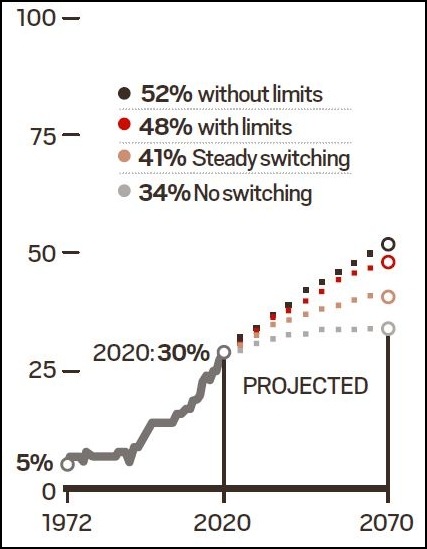Projections: Christians could fall to less than 50%, ‘nones’ could be more than 50% in US by 2070
According to estimates by Pew Research Center, a major nonpartisan think tank based in Washington DC, in 2020, about 64% of Americans, including children, were Christian.
 Pew cautioned that these are not the only possibilities, however, and that they were not meant as predictions of what will happen. (Representational/File)
Pew cautioned that these are not the only possibilities, however, and that they were not meant as predictions of what will happen. (Representational/File)Since the 1990s, large numbers of Americans have left Christianity to join the growing ranks of US adults who describe their religious identity as atheist, agnostic or “nothing in particular”. This accelerating trend is reshaping the American religious landscape, leading many people to wonder what the future of religion in America might look like, say, 50 years from now.
According to estimates by Pew Research Center, a major nonpartisan think tank based in Washington DC, in 2020, about 64% of Americans, including children, were Christian. People who are religiously unaffiliated, sometimes called religious “nones”, accounted for 30% of the US population. Adherents of all other religions — Jews, Muslims, Hindus, Buddhists — added up to about 6%.
Now, depending on whether religious switching continues at recent rates, speeds up or stops entirely, projections show that Christians of all ages could shrink from 64% to between a little more than half (54%) and just above one-third (35%) of all Americans by 2070, Pew said in a new report, ‘Modeling the Future of Religion in America’.
Over that same period, “nones” would rise from the current 30% to somewhere between 34% and 52% of the US population, the report said.
Pew cautioned that these are not the only possibilities, however, and that they were not meant as predictions of what will happen.
U.S. Christians projected to fall below 50% of population if recent trends continue

SCENARIOS
No switching
No one in US has changed or will change their religion after 2020.
Steady switching
Movement into and out of Christianity remains stable at recently observed rates. That is, in each new generation, 31% of Christians become religiously unaffiliated before they turn 30, and 21% of unaffiliated people become Christian.
Rising disaffiliation (with limits)
In each new generation, a growing share of Christians switch out before they turn 30, while a shrinking share of ‘nones’ switch in. But switching rate is capped to prevent the share of Christians who leave the faith from rising above 50%.
Rising disaffiliation (without limits)
In each new generation, a growing share of Christians switch out before they turn 30, while a shrinking share of ‘nones’ switch in. No cap is imposed on switching rates.
***
US ‘nones’ will approach majority by 2070 if recent switching trends continue

SCENARIOS
Rising disaffiliation (without limits)
In each new generation, a growing share of Christians switch out before they turn 30, while a shrinking share of ‘nones’ switch in. No cap is imposed on switching rates.
Rising disaffiliation (with limits)
In each new generation, a growing share of Christians switch out before they turn 30, while a shrinking share of ‘nones’ switch in. But the switching rate is capped to prevent the share of Christians who leave the faith from rising above 50%.
Steady switching
Movement into and out of Christianity remains stable at recently observed rates. That is, in each new generation, 31% of Christians become religiously unaffiliated before they turn 30, and 21% of unaffiliated people become Christian.
No switching
No person in America has changed or will change their religion after 2020.
Note: Trends based on surveys of US adults. 2020 estimate and subsequent projections show Americans of all ages. For 2020, it is estimated that religious composition of people of all ages roughly matches the adult composition. Sources: General Social Survey (1972-2006); Pew Research Center surveys (2007-2021); Pew Research Center projections (2020-2070).
—PEW RESEARCH CENTER
- 01
- 02
- 03
- 04
- 05






































